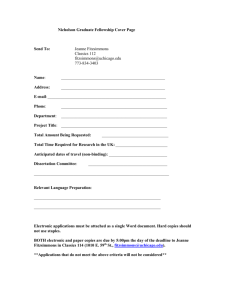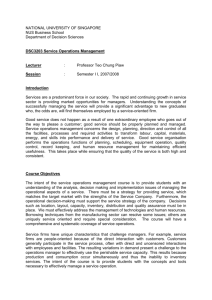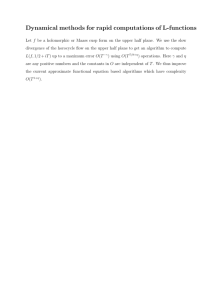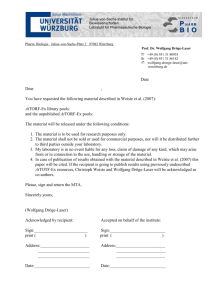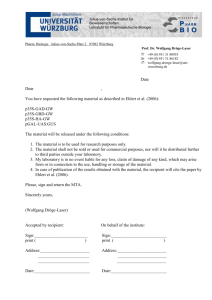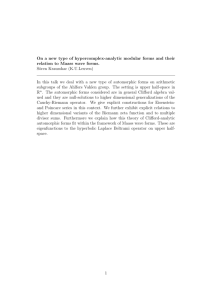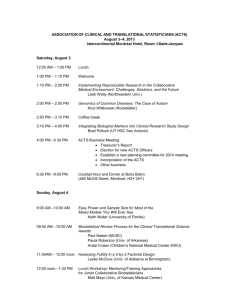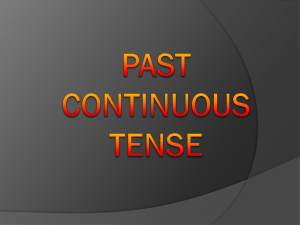Service Management – New Service Development
advertisement
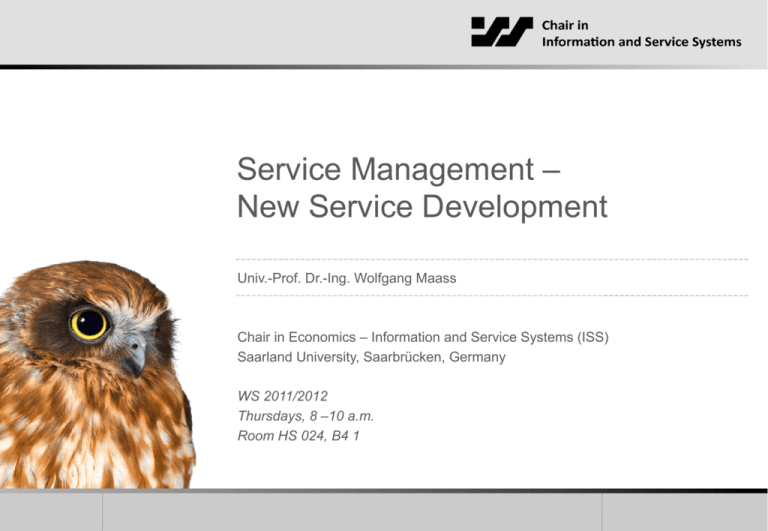
Service Management – New Service Development Univ.-Prof. Dr.-Ing. Wolfgang Maass Chair in Economics – Information and Service Systems (ISS) Saarland University, Saarbrücken, Germany WS 2011/2012 Thursdays, 8 –10 a.m. Room HS 024, B4 1 New Service Development • Starting with service concept and strategy to provide service with features that differentiate it from competition (cf. lecture #2 “Service Strategy”) • Design process is never finished • 2 basic types of service innovation (Chew, 2010) – Service enhancement for incremental growth – New growth idea (Anthony et al., 2008), or new service idea that could become a new growth platform (Laurie et al., 2006) • How to develop new services? -- e.g., a) NSD Process Cycle (Johnson et al., 2000) b) Service Innovation Process (Thomke, 2003) (Fitzsimmons & Fitzsimmons, 2011) Univ.-Prof. Dr.-Ing. Wolfgang Maass 09.11.11 Slide 2 A) NSD Process Cycle o o (Johnson et al., 2000; Fitzsimmons & Fitzsimmons, 2011) Full-scale launch Post-launch review Full Launch Enablers Development o o o o o o o Service design and testing Process and system design and testing Marketing program design and testing Personnel training Service testing and pilot run Test marketing People o Product Technology o Formulation of new services objective/ strategy Idea generation and screening Concept development and testing Systems Tools Design Analysis o o Univ.-Prof. Dr.-Ing. Wolfgang Maass 09.11.11 Business analysis Project authorization Slide 3 Technology as Innovation Driver • Technological advances are often basis for service innovation • e.g., Amazon: built up a loyalty customer base and gain competitive advantage as a technology first-mover (1995) • e.g., mobiles by Apple combined with app store represent platform for dozens of new services Source of technology Service example Service industry impact Power/energy Nuclear energy Less dependence on fossil fuel Materials Synthe:c engine oil Fewer oil changes Informa:on eCommerce Increase (local) market to worldwide market Univ.-Prof. Dr.-Ing. Wolfgang Maass 09.11.11 Slide 4 B) Service Innovation Process • Service innovation process consists of five phases (designed for new innovations where success is less certain) (1) Evaluate ideas – Conceive, assess, prioritize ideas from internal and external sources (2) Plan and design – Assign design needs, complete design, build rollout plan (3) Implement – Develop test plan, implement idea (4) Test – Monitor performance of idea, report results of fast feedback by market, improve process in a stable operating environment (5) Recommend – Complete, review and approve, communicate recommendation (Thomke, 2003) Univ.-Prof. Dr.-Ing. Wolfgang Maass 09.11.11 Slide 5 Service Design Elements • Service design elements -- creating a consistent service offering • Structural design elements: a. Delivery system – process structure, service blueprint, strategic positioning b. Facility Design – servicescape, layout c. Location – geographic demand, site selection, location strategy d. Capacity planning – strategic role, queuing models (Fitzsimmons & Fitzsimmons, 2011) Univ.-Prof. Dr.-Ing. Wolfgang Maass 09.11.11 Slide 6 Service Design Elements • Service design elements -- creating a consistent service offering Example: Hairdresser • Structural design elements: a. Delivery system – process structure, service blueprint, strategic positioning b. Facility Design – servicescape, layout c. Location – geographic demand, site selection, location strategy d. Capacity planning – strategic role, queuing models Co-production of customers; drying hair themselves Modern style; lounge style with coffee in waiting area Located in large malls Web-based booking system to choose date, service and employee (Fitzsimmons & Fitzsimmons, 2011) Univ.-Prof. Dr.-Ing. Wolfgang Maass 09.11.11 Slide 7 Service Design Elements • Managerial design elements: a. Information – technology, scalability, use of Internet b. Quality – measurement, design quality, recovery, tools c. Service encounter – encounter triad, culture, supply relationships, outsourcing d. Managing capacity and demand – strategies, yield management, queue management (Fitzsimmons & Fitzsimmons, 2011) Univ.-Prof. Dr.-Ing. Wolfgang Maass 09.11.11 Slide 8 Service Design Elements Example: Hairdresser • Managerial design elements: a. Information – technology, scalability, use of Internet b. Quality – measurement, design quality, recovery, tools c. Service encounter – encounter triad, culture, supply relationships, outsourcing d. Managing capacity and demand – strategies, yield management, queue management Looking up current number of customers in store on web page Free cutting of fringe and repairing of cuts Family-type atmosphere Walk-in customers – “Take a number” (Fitzsimmons & Fitzsimmons, 2011) Univ.-Prof. Dr.-Ing. Wolfgang Maass 09.11.11 Slide 9 Service Blue Printing • “The development of a new service is usually characterized by trial and error. Developers translate a subjective description of a need into an operational concept that may bear only a remote resemblance to the original idea. No one systematically quantifies the process or devises tests to ensure that the service is complete, rational, and fulfills the original need objectively.” (Shostack, 1984, p. 133) • “A service blueprint allows a company to explore all the issues inherent in creating or managing a service.” (Shostack, 1984, p. 135) • Service blueprint - capturing service design in a visual diagram (like building) • “Service blueprinting, which started as an entirely manual process, has been automated by companies to provide “living blueprints” accessible to key parties online […].” (Bitner et al., 2010, p. 210). (Fitzsimmons & Fitzsimmons, 2011) Univ.-Prof. Dr.-Ing. Wolfgang Maass 09.11.11 Slide 10 Service Blue Printing How to design a service blueprint? (1) Identifying processes - breakdown of complex processes into steps; identification of parts of service not seen by customer, e.g. purchasing of supplies (2) Isolating fail points – build (fail-safe) sub processes to correct possible errors (3) Establishing time frame – consideration of execution time of service as major cost determinant; calculating maximum of deviation (4) Analyzing profitability – quantifying costs of delay; establishment of time-of-serviceexecution standard to measure performance / control uniformity and quality; serves as model for distribution of service (Shostack, 1984, p. 135) Univ.-Prof. Dr.-Ing. Wolfgang Maass 09.11.11 Slide 11 Characteristics of Service Processes • Complexity – number of steps and sequences in process • Divergence – amount of discretion or freedom that server has to customize the service • Object of service process – goods, information, people • Type of customer contact – no contact, indirect, direct (Fitzsimmons & Fitzsimmons, 2011) Univ.-Prof. Dr.-Ing. Wolfgang Maass 09.11.11 Slide 12 Brainteaser • The taxonomy of services processes (Wemmerlöv, 1990) categorizes services according to the level of divergence, the degree of customer contact as well as the type of object of the service process. 10 Minutes • Fill out the table with exemplary service processes. • Discuss it with your neighbor! Univ.-Prof. Dr.-Ing. Wolfgang Maass 09.11.11 Slide 13 At Your Own Risk… Divergence Complexity • • • Steps of functions are dropped Specialization strategy • + resources focused on narrower service Leads to uniformity that tends to reduce costs, improve productivity Indicates shift to “economy of scale” (volume-oriented) + increases in reliability; more quality and service availability • • offering; easier distribution and control; expert position • • - Conformity and inflexibility, limiting - perceived as “stripped down”; danger of full-service alternatives customization options Complexity Divergence • • • • • Expanding service line Greater penetration in market + increased efficiency by maximizing revenue generated from each customer - confusing customers; reduction of overall service quality; danger of specialized competitors • • • Greater customization and flexibility tend to higher prices Indicates niche positioning strategy + prestige, customization, personalization - service difficult to manage, control and distribute; customers may not be willing to pay higher prices Univ.-Prof. Dr.-Ing. Wolfgang Maass 09.11.11 (Shostack, 1987) Slide 14 How to Design a Service System? • Service experience = theater; service design similar to staging a production (Grove & Fisk, 1992) • Experience economy in which service providers compete on the design of customer experiences (Pine & Gilmore, 1999) • Diverse approaches to design the service system a) Production-line approach b) Customer as co-producer c) Customer contact approach – Isolating technical core of low-contact operations from high-contact operations and design both separately (Chase, 2010); line of visibility; appropriate for processing-of-goods category d) Information empowerment – empowerment of employees and customers through IT (Spohrer & Maglio, 2010; Fitzsimmons & Fitzsimmons, 2011) Univ.-Prof. Dr.-Ing. Wolfgang Maass 09.11.11 Slide 15 A) Production-Line Approach • Delivery of routine services provided in controlled environments to ensure consistent quality and efficiency • Competitive advantage with cost-leadership strategy • Limited discretionary action of personnel – identical service at any location • Division of labor – total job is broken into simple tasks • Substitution of technology for people – e.g., ATM • Service standardization – limited service options guarantee predictability and preplanning; routine processes; helps to ensure service quality (Fitzsimmons & Fitzsimmons, 2011) Univ.-Prof. Dr.-Ing. Wolfgang Maass 09.11.11 Slide 16 B) Customer as Co-Producer • Customer represents productive labor at the moment it is needed – opportunity to increase productivity by shifting some activities to customer (Edvardsson et al., 2010) • Increasing degree of customization through co-creation – open innovation (van Hippel, 1986) • Cost leadership strategy with some customization • Self-Service – customer receives benefits for her labor in form of convenience • Smoothing service demand – smoothing variations in service demand; allows uniform utilization of capacity (e.g., midweek discounts) • Customer-generated content (Fitzsimmons & Fitzsimmons, 2011) Univ.-Prof. Dr.-Ing. Wolfgang Maass 09.11.11 Slide 17 Literature Books: • • Fitzsimmons, J. A. & Fitzsimmons, M. J. (2011), Service Management - Operations, Strategy, Information Technology, McGraw - Hill. Pine, B. J.and Gilmore, J. H. (1999), The Experience Economy: Work is Theatre and Every Business a Stage, Harvard Business School Press, Boston, MA. Papers: • • • • • • Anthony, S. D.; Johnson, M. W. & Sinfield, J. V. (2008), 'Institutionalizing Innovation', MIT Sloan Management Review 49(2), 45-53. Bitner, M. J.; Ostrom, A. L. & Morgan, F. N. (2008), 'Service Blueprinting: A Practical Technique for Service Innovation', California Management Review, 66-94. Bitner, M. J.; Zeithaml, V. A. & Gremler, D. D. (2010), Technology’s Impact on the Gaps Model of Service Quality'Handbook of Service Science', Maglio, Paul P. and Kieliszewski, Cheryl A. and Spohrer, James C. Chase, R. B. (2010), Revisiting “Where Does the Customer Fit in a Service Operation?” - Background and Future Development of Contact Theory'Handbook of Service Science', Maglio, Paul P. and Kieliszewski, Cheryl A. and Spohrer, James C. Chew, E. K. (2010), A Reflection From Telecommunications Service Perspective'Handbook of Service Science', Maglio, Paul P. and Kieliszewski, Cheryl A. and Spohrer, James C. Edvardsson, B.; Enquist, B. & Johnston, R. (2005), 'Cocreating customer value through hyperreality in the prepurchase service experience', Journal of Service Research 8(2), 149-161. Univ.-Prof. Dr.-Ing. Wolfgang Maass 09.11.11 Slide 18 Literature • • • • • • • • • • Edvardsson, B.; Gustafsson, A.; Kristensson, P. & Witell, L. (2010), Service Innovation and Customer CoDevelopment'Handbook of Service Science', Maglio, Paul P. and Kieliszewski, Cheryl A. and Spohrer, James C. Grove, S. J. & Fisk, R. P. (1992), 'The service experience as theater', Advances in Consumer Research 19, 455-461. Hippel, E. v. (1986), 'Lead Users. A Source of novel product concepts.', Management Science 32, 791-805. Johnson, S.; Menor, L.; Roth, A. & Chase, R. (2000), A critical evaluation of the new services development process: integrating service innovation and service design, in J.A. Fitzsimmons & M.J. Fitzsimmons, ed.,'New Service Development', Sage Publications. Laurie, D. L.; Doz, Y. L. & Sheer, C. P. (2006), 'Creating new Growth Platforms', Harvard Business Review, 80 – 90. Shostack, G. L. (1987), 'Service positioning through structural change', Journal of Marketing 51(1), 34—43. Shostack, G. L. (1984), 'Designing services that deliver', Harvard Business Review 62(1), 133—139. Spohrer, J. C. & Maglio, P. P. (2010), Toward a Science of Service Systems - Value and Symbols'Handbook of Service Science', Maglio, Paul P. and Kieliszewski, Cheryl A. and Spohrer, James C. Thomke, S. (2003), 'R&D Comes to Services – Bank of America’s Pathbreaking Experiments', Harvard Business Review, 71 – 79. Wemmerlöv, U. (1990), 'A Taxonomy for Service Processes and its Implications for System Design', International Journal of Service Industry Management 1(3), 20--40. Univ.-Prof. Dr.-Ing. Wolfgang Maass 09.11.11 Slide 19 Univ.-Prof. Dr.-Ing. Wolfgang Maass Chair in Information and Service Systems Saarland University, Germany Univ.-Prof. Dr.-Ing. Wolfgang Maass
